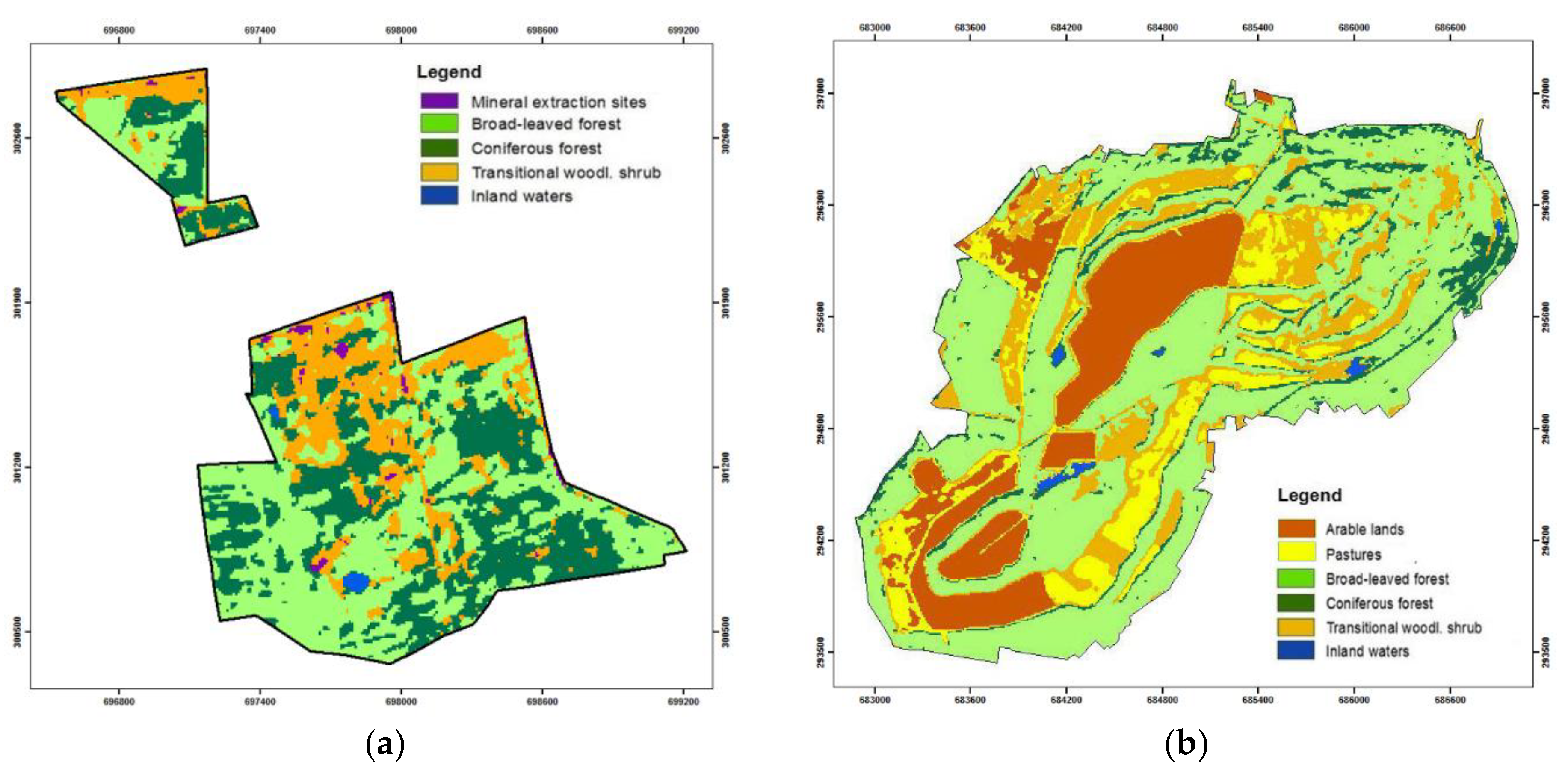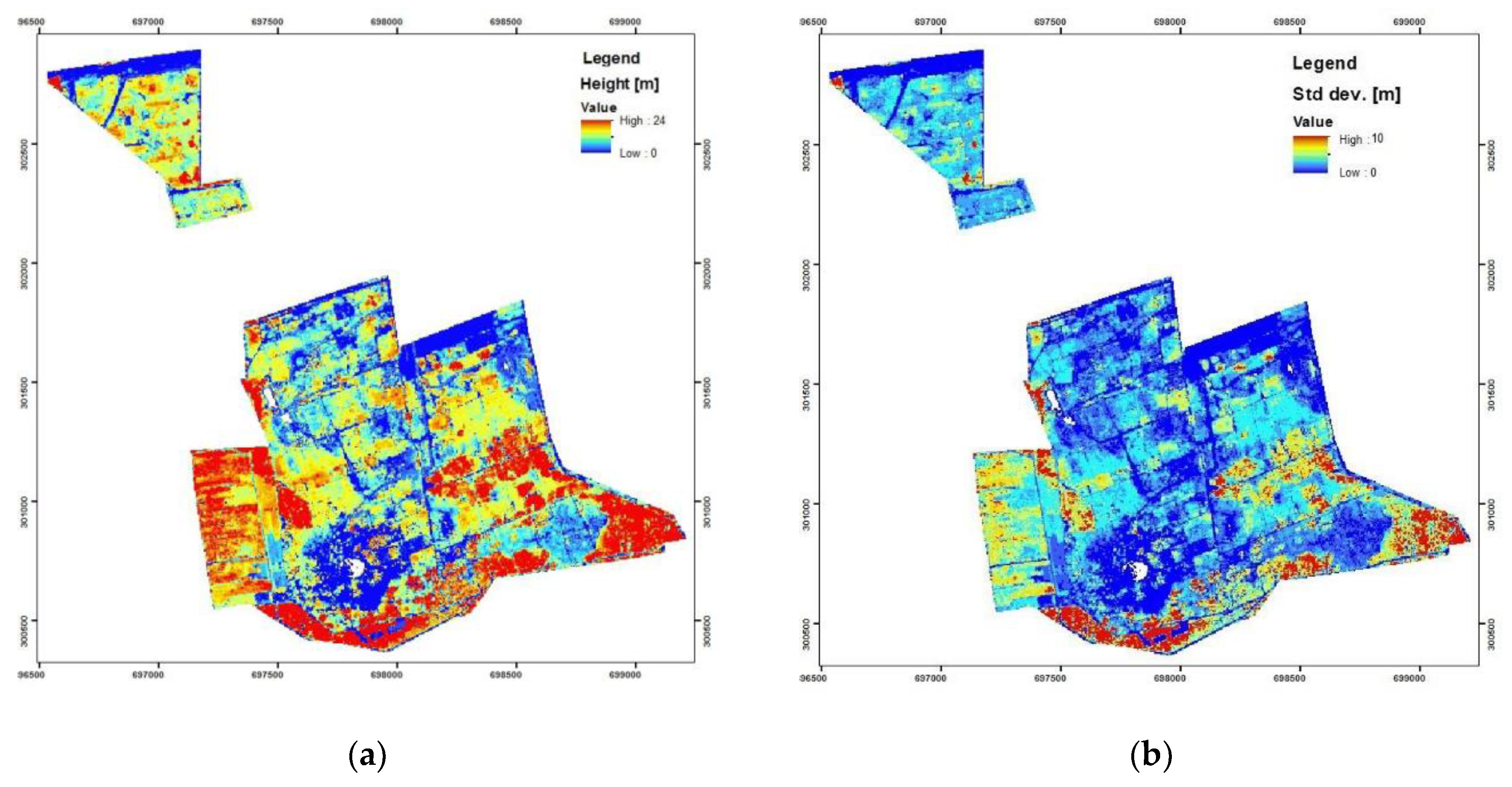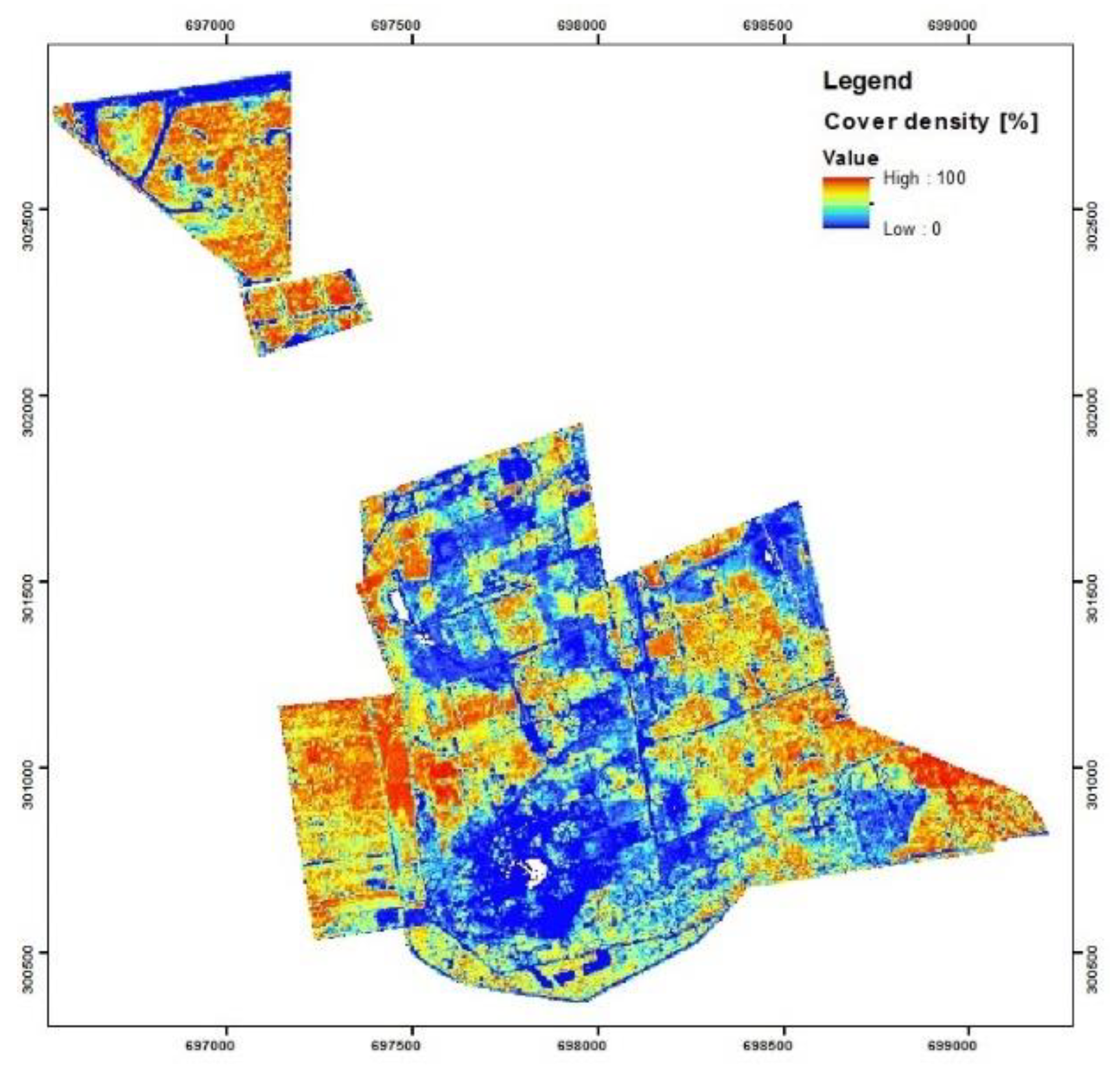Fusing Sentinel-2 Imagery and ALS Point Clouds for Defining LULC Changes on Reclaimed Areas by Afforestation
Abstract
1. Introduction
2. Materials and Methods
- Sentinel-2 image (Sentinel-2A, 8 August 2016, source: ESA);
- Airborne laser scanning point clouds (source: Head Office of Surveying and Cartography) from the ISOK project (pl. Informatyczny System Osłony Kraju przed nadzwyczajnymi zagrożeniami)—the IT System for the Protection of the Country. From ISOK, the products used were ALS LiDAR point clouds, delivered to almost the entirety of Poland. For the research areas, the point cloud density was 6 pts/m2 (acquired in 2012);
- Cadastral data (source: Geoportal and webEWID portal).
3. Results
- Jeziórko constituted 82.0% of the analyzed area in the year 2000, 88.8% in 2009 (showing a 6.8% difference between 2000 and 2009), and 95.5% in 2016 (a 6.5% difference between 2009 and 2016);
- Machów constituted 46.1% of the analyzed area in the year 2000, 57.3% in 2009 (showing an 11.2% difference between 2000 and 2009), and 60.7% in 2016 (a 3.4% increase from 2009).
4. Discussion
5. Conclusions
Author Contributions
Funding
Conflicts of Interest
References
- Bergen, K.M.; Dronova, I. Observing succession on aspen-dominated landscapes using a remote sensing-ecosystem approach. Landsc. Ecol. 2007, 22, 1395–1410. [Google Scholar] [CrossRef]
- Gołda, T. Rekultywacja; Uczelniane Wydawnictwa Naukowo−Dydaktyczne AGH: Kraków, Poland, 2005. [Google Scholar]
- Gołda, T.; Haładus, A.; Kulma, R. Geosozologiczne skutki likwidacji kopalń siarki w 19 rejonie Tarnobrzega. Inżynieria Środowiska 2005, 10, 70–72. [Google Scholar]
- Hajdo, S.; Klich, J.; Galiniak, G. Ekologiczne i technologiczne osiągnięcia w 40−letniej historii górnictwa otworowego siarki w Polsce. Górnictwo i Geoinżynieria 2007, 31, 199–215. [Google Scholar]
- Krzaklewski, W.; Pietrzykowski, M.; Likus, J.; Pająk, M.; Twaróg, A. Characteristic of selected soil properties and plant communities on reclaimed sites and sites left for succession on post-exploitation areas of Grzybów sulfur mine. Uniwersytet Zielonogórski. Zeszyty Naukowe. Inżynieria Środowiska 2016, 41, 78–86. [Google Scholar]
- Pająk, M.; Błońska, E.; Szostak, M.; Gąsiorek, M.; Pietrzykowski, M.; Urban, O.; Derbis, P. Restoration of Vegetation in Relation to Soil Properties of Spoil Heap Heavily Contaminated with Heavy Metals. Water Air Soil Pollut. 2018, 229, 1–15. [Google Scholar] [CrossRef] [PubMed]
- Pietrzykowski, M.; Krzaklewski, W. Reclamation of mine lands in Poland. In Bio-Geotechnologies for Mine Site Rehabilitation; Prasad, M.N.V., de Campos Favas, P.J., Maiti, S.K., Eds.; Elsevier: Amsterdam, The Netherlands; Oxford-Cambridge, UK, 2017; Volume 27, pp. 493–513. [Google Scholar]
- Szostak, M.; Wężyk, P.; Pająk, M.; Hawryło, P.; Lisańczuk, M. Determination of the spatial structure of vegetation on the repository of the mine Fryderyk in Tarnowskie Góry, based on airborne laser scanning from the ISOK project and digital orthophotomaps. Geod. Cartogr. 2015, 64, 87–99. [Google Scholar] [CrossRef]
- Wang, J.; Wei, Z.; Wang, O. Evaluating the eco-environment benefit of land reclamation in the dump of an opencast coal mine. Chem. Ecol. 2017, 33, 607–624. [Google Scholar] [CrossRef]
- Wężyk, P.; Szostak, M.; Krzaklewski, W.; Pająk, M.; Pierzchalski, M.; Szwed, P.; Hawryło, P.; Ratajczak, M. Landscape monitoring of post-industrial areas using LiDAR and GIS technology. Geod. Cartogr. 2015, 64, 125–137. [Google Scholar] [CrossRef]
- Yuan, Y.; Zhao, Z.; Niu, S.; Li, X.; Wang, Y.; Bai, Z. Reclamation promotes the succession of the soil and vegetation in opencast coal mine: A case study from Robinia pseudoacacia reclaimed forests, Pingshuo mine, China. Catena 2018, 165, 72–79. [Google Scholar] [CrossRef]
- Forkuor, G.; Dimobe, K.; Serme, I.; Tondoh, J.E. Landsat-8 vs. Sentinel-2: Examining the added value of sentinel-2’s red-edge bands to land-use and land-cover mapping in Burkina Faso. Giscience Remote Sens. 2018, 55, 331–354. [Google Scholar] [CrossRef]
- Sekertekin, A.; Marangoz, A.M.; Akcin, H. Pixel-based classification analysis of land use land cover using Sentinel-2 and Landsat-8 data. Int. Arch. Photogramm. Remote Sens. Spat. Inf. Sci.—Isprs Arch. 2017, 42(4W6), 91–93. [Google Scholar] [CrossRef]
- Marangoz, A.M.; Sekertekin, A.; Akçin, H. Analysis of land use land cover classification results derived from sentinel-2 image. In Proceedings of the 17th International Multidisciplinary Scientific GeoConference Surveying Geology and Mining Ecology Management, SGEM 2017, Albena and Varna, Bulgaria, 27 June–6 July 2017; pp. 25–32. [Google Scholar]
- Bork, E.; Su, J. Integrating LIDAR data and multispectral imagery for enhanced classification of rangeland vegetation: A meta-analysis. Remote Sens. Environ. 2007, 111, 11–24. [Google Scholar] [CrossRef]
- Falkowski, M.; Jeffrey, S.; Evans, J.; Martinuzzi, S.; Gessler, P.; Hudak, A. Characterizing forest succession with lidar data: An evaluation for the Inland Northwest, USA. Remote Sens. Environ. 2009, 113, 946–956. [Google Scholar] [CrossRef]
- Kolecka, N.; Kozak, J.; Kaim, D.; Dobosz, M.; Ginzler, C.; Psomas, A. Mapping secondary forest succession on abandoned agricultural land with LiDAR point clouds and terrestrial photography. Remote Sens. 2015, 7, 8300–8322. [Google Scholar] [CrossRef]
- Singh, K.; Vogler, J.; Shoemaker, D.; Meentemeyer, R. LiDAR-Landsat data fusion for large-area assessment of urban land cover: Balancing spatial resolution, data volume, and mapping accuracy. ISPRS J. Photogramm. Remote Sens. 2012, 74, 110–121. [Google Scholar] [CrossRef]
- Szostak, M.; Bednarski, A.; Wężyk, P. Monitoring of secondary forest succession on abandoned farmland using LiDAR point clouds. Geod. Cartogr. 2018, 67, 305–319. [Google Scholar] [CrossRef]
- Szostak, M.; Wężyk, P.; Tompalski, P. Aerial orthophoto and airborne laser scanning as monitoring tools for land cover dynamics: A case study from the Milicz Forest District (Poland). Pure Appl. Geophys. 2014, 171, 857–866. [Google Scholar] [CrossRef]
- Szostak, M.; Wężyk, P.; Király, G.; Hawryło, P.; Bednarski, A. Automation in the assessment of forest succession dynamics using airborne laser scanning data. In Proceedings of the International Multidisciplinary Scientific GeoConference Surveying Geology and Mining Ecology Management, SGEM, Albena, Bulgaria, 30 June–9 July 2018; pp. 41–48. [Google Scholar] [CrossRef]
- Axelsson, P. DEM generation from laser scanner data using adaptive TIN models. Int. Arch. Photogramm. Remote Sens. 2000, XXXIII/4B, 203–210. [Google Scholar]
- Andersen, H.E.; Reutebuch, S.E.; McGaughey, R.J. A rigorous assessment of tree height measurements obtained using airborne lidar and conventional field methods. Can. J. Remote Sens. 2006, 32, 355–366. [Google Scholar] [CrossRef]
- Hyyppä, J.; Hyyppä, H.; Litkey, P.; Yu, X.; Haggrén, H.; Rönnholm, P.; Pyysalo, U.; Pitkanen, J.; Maltamo, M. Algorithms and methods of airborne laser-scanning for forest measurements. In Laser-Scanners for Forest and Landscape Assessment, Proceedings of the International Archives of Photogrammetry, Remote Sensing, and the Spatial Information Sciences, Freiburg, Germany, 4–6 October 2004; Thies, M., Koch, B., Spiecker, H., Weinacker, H., Eds.; XXXVI–8/W2. [Google Scholar]
- McGaughey, R.J.; Carson, W.W.; Reutebuch, S.; Andersen, H.E. Direct measurement of individual tree characteristics from lidar data. In Proceedings of the Annual ASPRS Conference, Denver, CO, USA, 23–28 May 2004; American Society of Photogrammetry and Remote Sensing: Bethesda, MD, USA, 2004. [Google Scholar]
- Wężyk, P.; Szostak, M.; Tompalski, P.; Zajączkowski, G. The role of Airborne Laser Scanning in updating and revision of GIS databases—A case study in the Polish State Forest (Chojna District). In Proceedings of the Silvilaser 2010—10th International Conference on LiDAR Applications for Assessing Forest Ecosystems, Freiburg, Germany, 14–17 September 2010. [Google Scholar]
- Wężyk, P.; Tompalski, P.; Szostak, M.; Glista, M.; Pierzchalski, M. Describing the selected canopy layer parameters of the Scots pine stands using ALS data. In Proceedings of the SiliviLaser 2008—8th International Conference on LiDAR Applications in Forest Assessment and Inventory, Edinburgh, UK, 17–19 September 2008; pp. 636–645. [Google Scholar]
- Kondracki, J. Geografia Regionalna Polski; Wydawnictwo Naukowe PWN: Warszawa, Poland, 2009. [Google Scholar]
- Likus-Cieślik, J.; Pietrzykowski, M. Vegetation development and nutrients supply of trees in habitats with high sulfur concentration in reclaimed former sulfur mines Jeziórko (Southern Poland). Environ. Sci. Pollut. Res. 2017, 24, 20556–20566. [Google Scholar] [CrossRef] [PubMed]
- Michno, W.; Dziedzic, W.; Czajkowski, E. Przywracanie wartości użytkowych terenom górniczym na przykładzie KiZPS „Siarkopol”. In Proceedings of the Warsztaty Górnicze z Cyklu „Zagrożenia Naturalne W górnictwie”, Świeradów-Zdrój, Poland, 17–19 June 2009; pp. 197–211. [Google Scholar]
- Długosiewicz, F. Reclamation of post-industrial sites in the area of the Jeziórko sulhur mine. In Proceedings of the Open-Cast Mine Environmental Reclamation—with Special Focus on the Bełchatów Lignite Mine, Bełchatów, Poland, 8–9 June 1999; pp. 50–59. [Google Scholar]
- Likus-Cieślik, J.; Pietrzykowski, M.; Śliwińska-Siuśta, M.; Krzaklewski, W.; Szostak, M. Peliminary assessment of soil sulphur contamination and vegetation characteristic in the vicinity of former boreholes on afforested post-mine site Jeziorko. Geol. Geophys. Environ. 2015, 42, 371–380. [Google Scholar] [CrossRef]
- Likus-Cieślik, J.; Pietrzykowski, M.; Szostak, M.; Szulczewski, M. Spatial distribution and concentration of sulfur in relation to vegetation cover and soil properties on a reclaimed sulfur mine site (Southern Poland). Environ. Monit. Assess. 2017, 189, 1–12. [Google Scholar] [CrossRef] [PubMed]
- Pietrzykowski, M.; Likus-Cieślik, J. Comprehensive Study of Soil-Plant and Surface Water Chemistry Relationships in Highly S Contaminated Environment on Reforested Former Sulfur Borehole Mine Sites. Sustainability 2018, 10, 2442. [Google Scholar] [CrossRef]
- Kowalik, S. Właściwości chemiczne gleb industrioziemnych użytkowanych rolniczo i leśnie na zrekultywowanym zwałowisku Kopalni Siarki „Machów”. Roczniki Gleboznawcze 2004, 55, 239–249. [Google Scholar]
- Szostak, M.; Wężyk, P.; Hawryło, P.; Pietrzykowski, M. The analysis of spatial and temporal changes of land cover and land use in the reclaimed areas with the application of airborne orthophotomaps and LANDSAT images. Geod. Cartogr. 2015, 64, 75–86. [Google Scholar] [CrossRef]
- McGaughey, R.J. FUSION/LDV: Software for Lidar Data Analysis and Visualization. Software Manual. Available online: https://w3.ual.es/GruposInv/ProyectoCostas/FUSION_manual.pdf (accessed on 20 December 2018).
- Næsset, E. Predicting forest stand characteristics with airborne scanning laser using a practical two-stage procedure and field data. Remote Sens. Environ. 2002, 80, 80–99. [Google Scholar] [CrossRef]
- Akyürek, D.; Koç, Ö.; Akbaba, E.M.; Sunar, F. Land use/land cover change detection using multi-temporal satellite dataset: A case study in Istanbul new airport. Int. Arch. Photogramm. Remote Sens. Spat. Inf. Sci. 2018, 42(3W4), 17–22. [Google Scholar] [CrossRef]
- Bontemps, S.; Arias, M.; Cara, C.; Dedieu, G.; Guzzonato, E.; Hagolle, O.; Defourny, P. Building a data set over 12 globally distributed sites to support the development of agriculture monitoring applications with Sentinel-2. Remote Sens. 2015, 7, 16062–16090. [Google Scholar] [CrossRef]
- Haas, J.; Ban, Y. Urban Land Cover and Ecosystem Service Changes based on Sentinel-2A MSI and Landsat TM Data. IEEE J. Sel. Top. Appl. Earth Obs. Remote Sens. 2018, 11, 485–497. [Google Scholar] [CrossRef]
- Szostak, M.; Hawryło, P.; Piela, D. Using of Sentinel-2 images for automation of the forest succession detection. Eur. J. Remote Sens. 2018, 51, 142–149. [Google Scholar] [CrossRef]
- Whyte, A.; Ferentinos, K.P.; Petropoulos, G.P. A new synergistic approach for monitoring wetlands using Sentinels -1 and 2 data with object-based machine learning algorithms. Environ. Model. Softw. 2018, 104, 40–54. [Google Scholar] [CrossRef]
- Pitblado, J.R.; Amiro, B.D. Landsat Mapping of the Industrially Disturbed Vegetation Communities of Sudbury, Canada. Can. J. Remote Sens. 2014, 8, 17–28. [Google Scholar] [CrossRef]
- Szostak, M.; Likus-Cieślik, J.; Knapik, K.; Wężyk, P.; Pietrzykowski, M. Analysis of land use and land cover classes for the afforested post-mine site using Sentinel-2 images. In Proceedings of the International Multidisciplinary Scientific GeoConference Surveying Geology and Mining Ecology Management, SGEM, Albena, Bulgaria, 30 June–9 July 2018; pp. 41–48. [Google Scholar] [CrossRef]
- Townsend, P.; Helmers, D.; Kingdon, C.; McNeil, B.; de Beurs, K.; Eshleman, K. Changes in the extent of surface mining and reclamation in the Central Appalachians detected using a 1976–2006 LANDSAT time series. Remote Sens. Environ. 2009, 113, 62–72. [Google Scholar] [CrossRef]
- Urban, R.; Koska, B.; Moudry, V.; Solsky, M. Terrain of post mining site from airship lidar. In Proceedings of the 16th International Multidisciplinary Scientific GeoConference SGEM 2016, Albena, Bulgaria, 28 June–7 July 2016; pp. 577–584. [Google Scholar] [CrossRef]
- Blaschke, T.; Hay, G.J.; Kelly, M.; Lang, S.; Hofmann, P.; Addink, E.; Queiroz Feitosa, R.; van der Meer, F.; van der Werff, H.; van Coillie, F.; et al. Geographic Object-Based Image Analysis—Towards a New Paradigm. ISPRS J. Photogramm. Remote Sens. 2014, 87, 180–191. [Google Scholar] [CrossRef] [PubMed]
- Hay, G.J.; Castilla, G. Geographic Object-Based Image Analysis (GEOBIA): A New Name for a New Discipline. In Object-Based Image Analysis: Spatial Concepts for Knowledge-Driven Remote Sensing Applications, 1st ed.; Blaschke, T., Lang, S., Hay, G.J., Eds.; Springer: Berlin/Heidelberg, Germany, 2008; pp. 75–89. [Google Scholar]
- Szostak, M.; Wężyk, P.; Hawryło, P.; Puchała, M. Monitoring the secondary forest succession and land cover/use changes of the Błędów Desert (Poland) using geospatial analyses. Quaest. Geogr. 2016, 35, 5–13. [Google Scholar] [CrossRef]








| LULC Classes | Landsat 7 2000 | Orthophoto 2009 | Landsat 8 2013 | Sentinel-2 2016 |
|---|---|---|---|---|
| Mineral extraction sites | 17.5 | 2.0 | 2.6 | 1.2 |
| Transitional woodland shrub | 70.8 | 13.4 | 15.7 | 18.3 |
| Broad-leaved forest | 8.2 | 53.4 | 52.3 | 52.6 |
| Coniferous forest | 3.0 | 18.9 | 25.8 | 24.6 |
| Mixed forest | - | 3.1 | - | - |
| Waters | 0.5 | 2.4 | 3.6 | 3.4 |
| Other classes | - | 6.8 | - |
| LULC Classes | Landsat 7 2000 | Orthophoto 2009 | Landsat 8 2013 | Sentinel-2 2016 |
|---|---|---|---|---|
| Arable lands | 31.7 | 29.5 | 30.5 | 26.5 |
| Pastures | 22.0 | 4.2 | 18.4 | 12.2 |
| Transitional woodland shrub | - | 19.6 | - | 17.6 |
| Broad-leaved forest | 44.1 | 37.2 | 49.1 | 41.4 |
| Coniferous forest | 2.0 | 0.5 | 1.4 | 1.7 |
| Waters | 0.2 | 0.4 | 0.6 | 0.6 |
| Other classes | - | 8.6 | - | - |
© 2019 by the authors. Licensee MDPI, Basel, Switzerland. This article is an open access article distributed under the terms and conditions of the Creative Commons Attribution (CC BY) license (http://creativecommons.org/licenses/by/4.0/).
Share and Cite
Szostak, M.; Knapik, K.; Wężyk, P.; Likus-Cieślik, J.; Pietrzykowski, M. Fusing Sentinel-2 Imagery and ALS Point Clouds for Defining LULC Changes on Reclaimed Areas by Afforestation. Sustainability 2019, 11, 1251. https://doi.org/10.3390/su11051251
Szostak M, Knapik K, Wężyk P, Likus-Cieślik J, Pietrzykowski M. Fusing Sentinel-2 Imagery and ALS Point Clouds for Defining LULC Changes on Reclaimed Areas by Afforestation. Sustainability. 2019; 11(5):1251. https://doi.org/10.3390/su11051251
Chicago/Turabian StyleSzostak, Marta, Kacper Knapik, Piotr Wężyk, Justyna Likus-Cieślik, and Marcin Pietrzykowski. 2019. "Fusing Sentinel-2 Imagery and ALS Point Clouds for Defining LULC Changes on Reclaimed Areas by Afforestation" Sustainability 11, no. 5: 1251. https://doi.org/10.3390/su11051251
APA StyleSzostak, M., Knapik, K., Wężyk, P., Likus-Cieślik, J., & Pietrzykowski, M. (2019). Fusing Sentinel-2 Imagery and ALS Point Clouds for Defining LULC Changes on Reclaimed Areas by Afforestation. Sustainability, 11(5), 1251. https://doi.org/10.3390/su11051251








